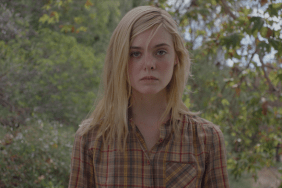The Beguiled Review: Sofia Coppola’s elegant and slow-burning remake is erotic and expertly performed by its cast
If you’ve seen director Sofia Coppola’s second feature film, 2003’s Lost in Translation, you might recall the opening shot, that of Scarlett Johansson‘s panty-wrapped, bed-bound behind. It’s a stunning first image, erotic, ordinary, intimate, humorous; cheeky, literally and figuratively. Coppola is a visualist and sensualist first and foremost, an artist who instinctually knows how to elicit emotional and physical responses from near static images and her movies often play like a succession of moving photographs and paintings. And almost always she sets the tone and theme for her films with that all-important first image. In her latest picture, The Beguiled (a loose remake of the Clint Eastwood/Don Siegel psychodrama, itself based on the novel by Thomas Cullinan), she outdoes herself, with a breathtaking Gothic shot of a curved, weeping tree-lined road and young girl walking down it, the title card then filling the screen, the font pink, feminine and pretty. It’s perfect. Perfect not only because of its aesthetic power, but because it expertly illustrates the soul of the film, that of the untamed, smothering, elemental grandeur and truth of nature and the dichotomy of the artifice of nature, or in this case femininity, more specifically the illusion of females being soft, lite, helpless, vulnerable. Women as societal decorations. When, of course, such male-sculpted nonsense is just that: nonsense.
The Beguiled stars Colin Farrell as battle-wounded Irish born Yankee solider John McBurney, who is discovered by little wandering Amy (Oona Laurence, Bad Moms) by her plantation-set girl’s school in the thick of the American Civil War-battered deep South. Striking up a conversation with the man, who is kind and articulate, the antithesis of what she has been led to believe “the enemy” represents, she helps McBurney back home, where the school mistress, Martha (an icy Nicole Kidman) and her prim and proper gaggle of students, reluctantly take him in and nurse him back to health. Isolated and repressed, the corseted cabal of women young and burgeoning begin responding the the charming, handsome soldier in different ways, the youngest of them enamored by him in a possibly paternal way and the older ones — specifically Martha, the flirtatious Alicia (Elle Fanning) and the anxious, miserable Edwina (Kirsten Dunst) — romantically and sexually. The women and their captive guest begin to form various connections and tensions rise as the previously air-tight, micro-society the women have carefully established begins to crumble, slowly, surely. And McBurney apparently revels in the hold he seems to have over the ladies and willingly manipulates them. But hell hath no fury and soon, McBurney finds himself in deeper than he bargained for.
Coppola has stated that her interest in the source film and book stemmed from a desire to flip the perspective of the narrative, and focus on the plight of the women as opposed to making McBurney the victim. The original 1971 film is a full-blown horror movie, told from the point of view of a man manipulated by a power-mad matriarch (Geraldine Page) and her protegees. But Coppola’s approach is radical and fascinating, not frightening, creating a sense of queasy unease and uncomfortable erotic electricity punctuated by moments of gore and bursts of violence. In this version of The Beguiled, the man in some senses reaps what he sews, his casual flirting and manipulations woefully backfiring as he underestimates just how quietly feral his female hosts are. Seeking to divide them with his desires, what happens is ultimately just the opposite.
On top of her lush visual palette, Coppola is also known for her use of music to propel her images but in The Beguiled, she forfeits score almost entirely (there is music by Phoenix, but it’s almost invisible), opting instead to let silences speak the loudest, along with faint rumbles of distant cannons popping in the distance, a constant reminder of the real horrors that pulse just beyond the utopia the women have designed in the school. It’s a genius move, allowing her to richly evoke the sense of the period and immerse us in the world these characters inhabit. And Coppola once more casts flawlessly, with Kidman offering a mirror, non-supernatural Americanized answer to her repressed matriarch in The Others, Coppola’s Marie Antoinette star Dunst providing a stunning portrait of a woman pining for sex and salvation from a life she quietly despises, and Fanning in some ways taking her The Neon Demon character and transposing her to a period piece. The younger actresses match their elders every step of the way, with Laurence especially shining.
If The Beguiled has a flaw, it’s perhaps in that it’s too muted and compact. It ends too soon. We want to spend more time here, in this sensual, dangerous and desperate world that Coppola has so carefully created. We want more. In that, the viewer is left in some respects, in the same state that the director leaves her characters: in the same position as when we found them, but both slightly more broken and yet oddly stronger and yet ultimately still slave to frustration and desire.
The Beguiled
-
The Beguiled

-
The Beguiled

-
The Beguiled

-
The Beguiled

-
The Beguiled

-
The Beguiled

-
The Beguiled

-
Unnamed 9

-
The Beguiled

-
The Beguiled

-
The Beguiled

-
The Beguiled

-
The Beguiled

-
The Beguiled

-
The Beguiled

-
The Beguiled

-
The Beguiled

-
The Beguiled

-
The Beguiled

-
The Beguiled

-
The Beguiled

-
The Beguiled

-
The Beguiled

-
The Beguiled

-
The Beguiled

-
The Beguiled

-
The Beguiled











